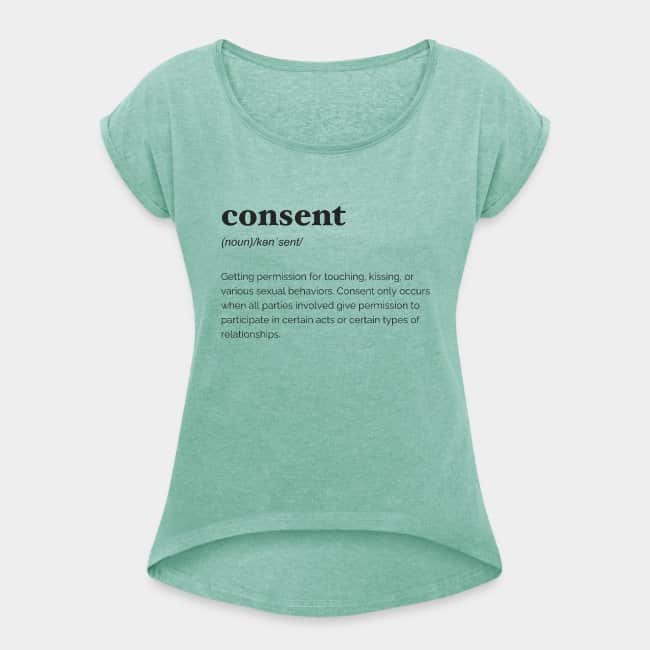Content/trigger warning: rape play, violence
What is CNC or metaconsensus?
BDSM is always based on mutual consent, the consensus between all parties. This distinguishes BDSM from an act of violence or assault, because it means that everyone agrees with the actions. In this context, we often come across the abbreviation CNC. The abbreviation CNC stands for “consensual non-consent”, which literally translates to “consented non-consent”.
Basically, CNC is about something happening that has not been explicitly agreed. It usually involves fantasies of being forced into sex, services or other acts by one party. It is therefore the will that something happens against your will.
“I like it when I don’t like it. I want this, even if I don’t want it.”
This is actually an oxymoron, because consensus is the most important pillar of BDSM. Nevertheless, this practice is often part of a D/s relationship. After all, otherwise you give away part of your plans when individual acts or sessions are discussed beforehand. In addition, many Subs find it very arousing when they don’t know what to expect.
Nevertheless, CNC always requires detailed preliminary talks in which hard and soft limits must be explicitly discussed. CNC is not a free pass, not a universal authorization for free acts that can be performed on another person without consequences.
Distinction between CNC and metaconsensus
Metaconsensus is often used in connection with CNC. The word “meta” in connection with a noun expresses that something is on a higher level or level, is classified above or behind something. Metaconsensus could therefore be roughly translated as “super-consent” or “blanket consent”. This means that once consent to practices has been given, it does not have to be repeated for every session. This means that a part receives blanket permission to carry out these specific actions without prior notice. Metaconsensus is therefore not the same as CNC, even if CNC cannot be agreed without metaconsensus.
And: blanket consent can also be revoked and should ideally even be renewed continuously to ensure that the participants still want the same thing.
CNC and consensus
As mentioned above, with consensual non-consent it is also important to negotiate the underlying consensus first by talking specifically about practices, actions and boundaries. Because agreeing to CNC does not mean removing all boundaries! A hard limit is also inviolable here until it is indicated that it can be dissolved. This is precisely why it is important to communicate mutual ideas honestly and openly.
A safeword is also important in a CNC system. While a safeword is considered “non-erotic” in many scenarios, it is particularly important here. Because when it comes to coercive fantasies, there will often be statements such as “No, please don’t, that hurts”, which is what you want to provoke here. Therefore, a detached safeword that is not used reflexively in unpleasant situations is absolutely necessary.
The legal situation must also be taken into account here, as “no” is “no” in the eyes of the law, and even a consensus discussion or a written agreement does not change this. It is therefore in the interests of all parties involved to put appropriate measures in place.
What can consensual non-consent look like?
The best-known form of CNC is rape play, i.e. the re-enactment of the act of rape as role-play. A fantasy that is relatively widespread among women. In a 2008 survey on the idea of erotic rape play, around 30 to 60 percent of women stated that they had fantasies in which they were forced to perform sexual acts against their will. Of these, between 9 and 17 percent cited rape play as their most frequent and favorite fantasy. These fantasies are therefore not only common among BDSM practitioners, but also among vanillas.
However, CNC can also involve individual acts that have not been discussed beforehand, such as the use of gags, plugs, clamps or restraints. This can include determining the time or location of an outdoor session, for example. Or even the initiation of a session through certain gestures or actions.
Ripping clothes can often be a good way to start. But also using others or similar. The practice of somnophilia, i.e. sexual acts on a person who is asleep, not clearly responsive or similar, is also part of the CNC. There are also less violent ways in.
Examples of the structure and execution of CNC sessions can be found, for example, on the blog bound-together.net by BDSM bloggers Mimsy and Vagabond.
The community and CNC
If you ask the community about their views on CNC, you will get a wide variety of answers. The following summaries are subjective perceptions gathered for this article via social media, personal contacts and anonymous letters.
For some members, RACK and CNC go hand in hand. RACK refers to the deliberate practice of dangerous practices such as CBT, needle play or breath play, which cannot be practiced under the SSC (Safe, Sane and Consensual) system, as they always carry a certain risk of injury.
Furthermore, it is often assumed that CNC involves breaking hard limits, i.e. that it is always about exceeding limits. This can be the case with soft limits, i.e. limits that are lifted by Sub under certain circumstances. These are often exceeded at CNC when the Dom deems it appropriate. However, not always necessarily under the circumstances that Sub would require.
However, playing with such transgressions is only possible with a lot of overcoming and attention. A delicate balance must be maintained so that these actions do not veer in a negative direction. In no case, however, is this approach a matter of course or even the main component of CNC.
What to look out for with consensual non-consent?
Aftercare
A CNC session is often communicated differently than a normal session. Therefore, it often needs to be made clear again at the end that the scene is over. It makes sense to verbally say “We’re done now”, clear away all the toys and ideally even move to another room.
In contrast to most other sessions, you should be careful with close physical contact after a rape play or overpowering scenario. As these types of play are often about physical superiority, a hug, for example, can almost seem like a continuation of the play. An offered hand or contact via the palms of the hands is a gentler transition.
It therefore makes the most sense to ask the other person what he or she needs at the moment. Some people want closeness, others distance. Some want to turn on their playlist, watch a series or a movie, others simply need peace and quiet.
Otherwise, the same applies here: Have your own aftercare routine. Take care of and provide for basic physical needs and have blankets, drinks and food ready, as well as things that your partner associates with safety. Let the submissive person slowly regain self-control.
Personal responsibility and conscientiousness
With CNC, the question quickly arises as to who is responsible. If the submissive person does not set reflected boundaries, they quickly run the risk of being hurt. It should also be noted that it is not always easy to defend oneself against a partner, as it is a specific and determined action against them. In many CNC games, resistance and unwillingness are clearly desirable and are part of the appeal. Nevertheless, these are actions with a non-consenting person, even if it happens by consensus.
For example, a perpetrator-victim situation is created by the dominant person deliberately pushing the submissive person to the ground and tearing their clothes. The submissive is likely to resist physically and verbally and show emotional signs. It takes strength to overcome this inner inhibition threshold.
It is therefore also important to assert personal responsibility. A dom:me also needs aftercare, especially when strong statements such as “no”, “I don’t want this” or “you’re hurting me” have been made. Furthermore, if both parties are in a close relationship with each other, conflict can arise if one person hurts or overpowers the other while they are defending themselves. It could even violate mutual trust or lead to anxiety. The possible consequences of such actions are simply different from those of an ordinary session.
All of these circumstances, consequences, effects and their possible extent must be taken into account by those involved, but above all by the dom, and this awareness must be handled with care. They must be able to fully assess their own limits and those of the other person in order to minimize risks as much as possible. Because as a dom:me, you often find yourself in the role of the perpetrator in these types of games.
You’re kinky, always playing with consent and want to show it? #ExpressYourKink with the items from the Deviance Shop! Here you’ll find a wide selection of everyday clothing, accessories, and decorative items with matching terms and designs.
Do you like what you see? You can find these and many more clearly ambiguous designs on a wide range of products from shirts and tops to sweaters and hoodies, as well as caps and home accessories in the Deviance Shop! #ExpressYourKink












